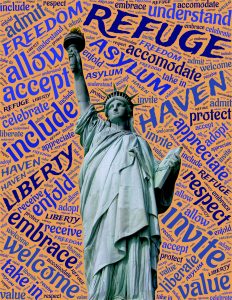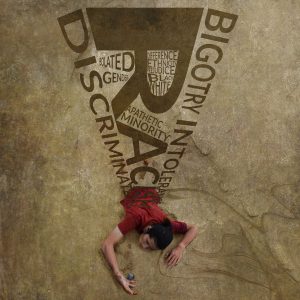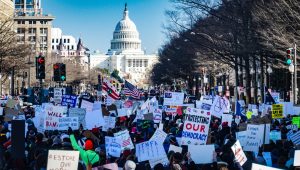3 Chapter 3: Citizenship, Immigration, Xenophobia
Introduction
The American identity is often associated with certain symbols, concepts, and assumptions: bald eagles, freedom, and a “melting pot.” However, these labels are perceptions rather than universal, concrete reality and can do more harm than good, particularly in regards to the division between immigrants and native-born citizens. The dominant social construct of the American identity relies and reinforces nativist and xenophobic ideology, which is exemplified by naturalization policies and perceptions of immigrants.
Key Terms
For a thorough understanding of the text, some keywords and their definitions are provided here, as provided
Immigrant: A person who comes to a country to permanently live there (Merriam-Webster).
Legal or documented immigrants: For the purposes of this chapter, legal immigrants are defined as individuals who were granted legal residence in the United States. This would include those from other countries who were granted asylum, admitted as refugees, admitted under a set of specific authorized temporary statuses for longer-term residence and work, or granted lawful permanent residence status or citizenship. (Immigrant and Refugee Families, 2nd Ed. by Jaime Ballard, Elizabeth Wieling, Catherine Solheim, and Lekie Dwanyen)
Illegal or undocumented immigrants: Illegal or undocumented immigrants are foreign-born non-citizens residing in the country who have not been granted a visa, or were not given access (i.e., inspected) by the Department of State upon entrance (US Visas, n.d.). They may have entered the country illegally (e.g., crossing the borders), or may have entered the country legally with a valid visa but have stayed beyond the visa’s expiration date. Other terms also used in immigration research include: unauthorized immigrants, undocumented immigrants, and illegal immigrants. However, in this chapter, “undocumented immigrant” will be used to reference illegal and unauthorized immigrants.
Refugee: One that flees; a person who flees to a foreign country to escape danger or persecution.(Merriam-Webster)
Asylum: A place of security; a protection from arrest and extradition given especially to political refugees by a nation or by an embassy or other agency (Merriam-Webster).
Xenophobia: Fear and hatred of strangers or foreigners or of anything that is strange or foreign (Merriam-Webster).
Citizen: A person who legally belongs to a country and has the rights and protection of that country (Merriam-Webster).
Citizenship: the fact or status of being a citizen of a particular place (Merriam-Webster)
Naturalization: The course of action undertaken to become a citizen of a country other than the country where one was born (Merriam-Webster).
Assimilation: The process of being absorbed into the cultural tradition of a dominant population or group (Merriam-Webster).
Nativism: a collective attempt by self identified natives to secure or retain prior or exclusive rights to valued resources against the challenges reputedly posed by resident or prospective populations on the basis of their perceived foreignness (Fry 179).
Prejudice: an unfair feeling of dislike for a person or group because of race, sex, religion, etc.
Naturalization: the course of action undertaken to become a citizen of a country other than the country where one was born (Merriam-Webster)
Xenophobia: Fear of strange or foreign things
Religion: an organized system of beliefs, ceremonies, and rules used to worship a god or a group of gods (Merriam-Webster)
The American Identity as a Social Construct
“American” does not have a simple definition. There are a multitude of ways and a variety of perceptions that can describe a national identity, and these notions are influenced by different experiences and perspectives. For example, the many aspects of a person’s identity, race, ethnicity, gender, sexuality, inform their idea of what it means to be an American. There is no single, concrete definition.
But despite its socially-constructed nature, there is a dominant perception of an American identity that can overshadow others. Americanness is often associated with whiteness and Eurocentric ideals. The United States’ constructions of success and power are defined by this dominant perception, meaning the narrative is controlled by those who already have both. Race, another social-construction, is used to maintain social stratification, and therefore, inequalities (Brown 7). As a result, governmental policies, social expectations, and norms are built for or around whiteness. Racial minorities are seen as to not fit these standards, so they are viewed as foreign or “other.” Therefore, this notion of the American identity is not always accepting of immigrants, and prejudice towards immigrant communities is visible within the United States, as demonstrated by the criminalization of immigrants or intensified border control and immigration policy.
Reasons for Immigration
Immigrants choose to move from their homeland and start a new life for many reasons. For those coming to the United States of America, some draws may include better housing, safety, better job prospects, and/or reunification with family. Pushes away from their country of origin may include lack of opportunities, war, famine, or persecution.
For those who come to the United States seeking employment, they are in good company. Immigrants make up 17% of the labor force at 29 million workers (Budiman) and are accepted by over half the U.S. population as strengthening the country. Many undocumented immigrants that come to the U.S. are taken advantage of by companies who use them for cheap labor and then get them deported once they are no longer of use.
Immigration Policies & Border Control

Some of the most important pieces of legislation in regards to immigrants are listed here. The Development, Relief, and Education for Alien Minors Act allows people who entered the US as undocumented minors to get conditional residency, along with the right to work, and eventually get permanent residency.
Deferred Action for Childhood Arrivals allows some undocumented people in the United States after being brought to the country as children to receive a renewable two-year period of deferred action from deportation and become eligible for a work permit in the U.S.
Immigration and Customs Enforcement or ICE is a sister department of the United States Border Patrol, a unit of U.S. Customs and Border Protection. They are tasked with enforcing border control. ICE is responsible for deportation and holding people at the border for unreasonable amounts of time.
While terms like ‘alien’ may be legally accurate to the status of some immigrants, the usage of such terms adds a sense of distance and hostility towards those immigrating. Other language would be far more appropriate.
Citizenship & Naturalization
Citizenship expresses membership to a community. In civic terms, being a citizen typically means having access to the rights and protection of a nation. Citizenship also implies “duties” to a country, which refers to certain civic responsibilities, defined by the government and society (Coffé and Bolzendahl 50). However, both rights and duties are rarely translated into practice to match their ideal definitions. Discrimination and inequalities mean that minority groups have not or are not afforded these rights, and civic duties have a variety of conceptualizations (Coffé and Bolzendahl).

Naturalization is one method available to immigrants in order to become a United States citizen. The process is lengthy with many steps and a long timeline established by Immigration and Nationality Act. The first few requirements are that one must be at least 18 and must have been a lawful permanent U.S. resident (or have a green card) for at least 5 years before filing for an Application for Naturalization or an N-400 form. One must have physically resided in the country for at minimum 30 months. One must also be “of good moral character” or have not committed any crimes. Other requirements include a demonstration of the English language and an understanding of the United States’ history and policies. These proficiencies are tested during the naturalization interview in which an English and civics test is administered. The English test includes a speaking, writing, and reading portion. The 2008 version of the civics test is an oral test consisting of 10 questions out of a possible 100. Applicants must have had 6 correct answers out of 10 to pass. However, the test was updated in 2020, so there are 128 possible questions, and 12 correct answers out of 20 total are required to pass. Once the naturalization interview is complete, the next step is to take the Oath of Allegiance. One must continuously reside in the country from the time the paperwork is filed and until citizenship is granted, which is about 14.5 months. There are exemptions to this process for spouses of United States citizens, children, and military members.
Immigrants may decide to or not to become a citizen for many different reasons. For instance, the legal rights and protection or the possible economic benefits and job opportunities (such as those in government requiring citizenship) are a few factors that may help someone choose to go through the naturalization process. The country of origin, its distance from the United States, and personal identity and characteristics can also impact the decision (Amuedo-Dorantes and Lopez 845). Additionally, Catalina Amuedo-Dorantes and Mary Lopez suggest that increased internal immigration enforcement and escalating xenophobia are factors that also affect an immigrants inclination to naturalize, and in fact, may increase their likelihood to do so. According to the study “Timing of Naturalization Among US Immigrants” in the Journal of International Migration and Integration, 40% of immigrants naturalize by the fifth year of eligibility, about 75% by the 20th year, and around 90% by the fortieth year (Dziadula 797).
Nativism
Nativism is the positional dynamics between self-identified natives of a country and those who are perceived to be “foreign” (Fry 5). Although foreign individuals can be, and in many cases are, immigrants, the concept of “foreign” applies to all individuals, including native born citizens, that are perceived to be different from the collective community or dominant group through a person’s race, ethnicity, spoken language, accent, religion, etc. The degree of foreignness native-born citizens ascribe to certain classes of immigrants is more important to the collective perception than the holding of citizenship (Rodriguez 147). Through the frameworks of Nativism this ascribed foreignness is viewed as a threat to self-identified natives, as they believe foreigners will upset their current privileges: “[Nativism is] a collective attempt by self-identified natives to secure or retain prior or exclusive rights to valued resources against the challenges reputedly posed by resident or prospective populations on the basis of their perceived foreignness” (Fry 179). The Nativism mentality is used to ostracize and devalue others in order to maintain native born entitlement and preserve prejudice by limiting immigrant opportunities.
Scholars have interpreted the relationship between self-identified natives and foreigners in various different ways. However, the overall consensus of scholars is that nativism is a response to a “perceived group threat” and nativist hostility can be located in “individual prejudices and stereotypes” (Fry 10). Multiple overlapping frameworks or models have been used to come to these conclusions, explaining the occurrence of nativism in society. The four models of nativism are as follows: nationalism, resource competition, prejudice, and group position. Forewarning: The idea that there are only four models of nativism may be misleading, as there are many variants of the frameworks that were just listed. For example, “there is no single nationalism model used by scholars to examine nativism,” nor should there be (Fry 11). Depending on the origin of nativist activities, these models will adapt and change. The models specified in this textbook are a collaboration of many scholars’ interpretations seen through an American lens.
The nationalism model is “represented as a variant of American nationalism or as competition for scarce resources” (Fry 11). For instance, those with a nativist mentality may feel an overwhelming pride for their nation, as seen in the original definition of nationalism, however, this pride will be defensive in nature. This defensive form of nationalism stems from the fear that immigrants and ascribed foreigners will seize limited valued resources from native born citizens. This is a fear founded in the American discourse on immigration reform, which is fairly economic in nature, “often referring to the cultural and fiscal ‘costs.’ The ‘rhetoric of exclusion’ frequently contain arguments about limited resources and national sovereignty” (Fry 11). A native-born individual who exhibits this behavior will view someone/something as “unamerican” and will vehemently oppose it because they believe it is threatening their American way of life. Most commonly, they believe immigrants are threatening their opportunities and privileges they feel entitled to as native-born citizens of the United States.
Similar to the nationalism model, the resource competition model is based in economics. Unlike the nationalism model, however, the resource competition model focuses on exclusionary practices, not exclusionary ideas. In this model, self-identified natives mentally and physically oppose “foreignness” by attempting to block immigrant opportunities and preying on foreign stereotypes. This practice is called social closure and it occurs when one social group takes “some externally identifiable characteristic of another group of (actual or potential) competitors—race, language…residence, etc.—as a pretext for attempting to close certain social and economic opportunities to them” (Fry 16). The competition for economic resources and opportunities between native-born and foreign groups, immigrant or otherwise, is not real but a group perception that provokes nativist hostility and action (Fry 17). Although this behavior may be seen at the individual level, ‘“it seems more probable that ethnic conflicts as well as xenophobic movements are waged over collective goods’” (Fry 17).
While the models of resource competition interpret nativist behavior as a “rational response to objective conditions,” the prejudice model assumes that “there is a subjective and irrational basis for nativist and racist hostility” (Fry 19-20). Those who are characterized by prejudiced behavior have a paranoid mentality that pushes them to believe in the irrational, which may be why those with nativist behavior are more likely to believe in conspiracy theories. According to scholars, “there is nothing inherently prejudicial about conspiracy theories” (Fry 20). However, “the inability of certain individuals to cope with profound changes in society (particularly in terms of their own social status) manifests itself in various forms of prejudice” (Fry 20). When substantial social changes occur, those in native-born groups feel as if their social standing or privilege is threatened. To reclaim their sense of control or to reinstate their perception of dominance, they use conspiracy theories as evidence for their prejudiced ideas.
Social changes can be classified as national crises (such as war, economic downturns, natural disasters, the Covid-19 pandemic, etc.) and “acute socio-psychological anxiety and fear” (such as the Red Scare, the War on Terror, McCarthyism, Asian discrimination on the basis of Covid, etc.) (Rodriguez 147). Vitriolic debates on immigration policy normally succeed these events, as well as violent attacks or expression of emotion that are racially or economically nativist in nature: “The consequences for perceived foreigners—many of whom are actually native-born citizens—can be calamitous, e.g., internment, mass deportations, racial or religious rioting, discrimination, harassment, labor market stratification, residential segregation, profiling, surveillance, etc.” (Rodriguez 147).
The group position model integrates all the previous models into one analytical framework. The positional relationship between groups, such as race, religion, ethnicity, etc., is established in a certain group’s process of identifying conceptions of themselves and others. By forming these preconceived notions and applying them to a social structure, a “group position” is formed (Fry 23). This is not an individualistic perception of nativism, but a collective perception. This is important because prejudice between groups cannot be explained by individual characteristics (Fry 23). This model explains why dominant groups feel entitled to certain privileges, as there is a preconceived notion that they are more important on a ladder of social hierarchy which has been established throughout history. Many scholars use the group position model to “examine racism and nativism as responses to a perceived threat,” as when dominant groups’ privilege is challenged, discrimination is likely to occur (Fry 23).
Citizenship, Immigration, and Xenophobia in the 21st Century
In the United States, social expectations and deep-seated notions of normal reinforce a sense of “otherness” and intolerance. As a result, communities face discrimination based on their religion, race, and their status as an immigrant. This nativist mindset is evident in the behavior, events, and policies from the past decades, which highlights subtle and overt manifestations of xenophobia.
In most Western countries, religion is not formally used to define immigration and naturalization policies. Although, slow integration of non-Christian immigrants and a rise in anti-immigration sentiments due to an influx of immigrants may deceive one into believing otherwise, “formal laws of immigration and naturalization in the Western world are essentially secular.” (Fisher 223). The continual naturalization of Muslims and other persons of religious minorities where they receive full political rights is irrefutable proof of secular immigration and naturalization policies in the United States (Fisher 223). However, the existence of Executive Order 13769 (Trump’s 2017 Muslim travel ban), which, although reformed, was constructed with anti-Muslim rhetoric, and the structuring of naturalization test to not grant legal status to religious radicals, calls the detachment of religion in immigration policy into question (Fisher 223). The rise in prejudice towards certain religious groups in the United States, indicates a correlation between a collective nativist mindset and an emergence of non-secular based immigration policies.
Despite the idea that Asians are the “model minority,” xenophobia and anti-Asian discourse have a long history within the United States. The persisting perception that Asians are a threat to national security has resulted in harmful consequences for Asian communities, including the formal exclusion of Chinese immigrants in 1882 and the internment of Japanese Americans in response to the attack on Pearl Harbor. A recent form of anti-Asian discrimination is fueled by the COVID-19 pandemic. Fear, uncertainty, and misinformation surrounding the source of the virus has exacerbated already existing biased views of Asian populations. Consequently, Asian Americans were associated with the virus and blamed for its spread.
A significant amount of anti-Asian violence and hate crimes have occurred since the start of the pandemic. From March 2020 to June 2021, there were over 9,000 reported cases of discrimination. According to the Asian Pacific Policy and Planning Council’s “Stop AAPI Hate National Report,” verbal assault and shunning make up the majority of incidents at 63.7 percent and 16.5 percent, respectively. Physical assault, civil rights violations, and online harassment constitute the remaining instances. This scapegoating and intolerance further exoticizes and “others” Asian Americans, creating discrimination or inequalities in a variety of circumstances. For instance, pandemic-related anti-Asian rhetoric magnifies pre-existing health disparities. According to Le et al., Asian American populations who are low-income, older in age, have limited English proficiency, or are undocumented, are already vulnerable to neglect regarding health care but may also be most adversely affected by COVID-19. Asian Americans may also be deterred from seeking medical attention for fear of facing xenophobia (Le et al.) Additionally, states’ reports of COVID-19 cases either do not include information for Asians or their percentage of reported cases is disproportionate to their population’s representation.
Overall, the pandemic-related anti-Asian discourse is a current example of xenophobic attitudes and demonstrates the discrimination immigrant communities may face.
Conclusion
A nativist or xenophobic mentality affects one’s collective or individual perception of immigrant communities. A viable method to combat these prejudiced mentalities is to be aware of your own biases, as well as the dominant biases in your community. It will take much effort to alter the dominant perceptions of American society. However, you can start the change and advocate for American immigrants, policies, and human rights.
References
Amuedo-Dorantes, & Lopez, M. (2020). “Recent changes in immigration policy and U.S. naturalization patterns.” Review of Economics of the Household, 19(3), 843–872. https://doi.org/10.1007/s11150-020-09510-.
Brown, R. K., & Brown, R. E. (2017). Race, religion, and immigration policy attitudes. Race and Social Problems, 9(1), 4-18. Doi: http://dx.doi.org.ezproxy.morris.umn.edu/10.1007/s12552-017-9201-5.
Coffé, H., Bolzendahl, C. (2013). “Racial group differences in support for citizenship duties and rights in the US: Racial differences citizenship duties and rights.” Acta Polit 48, 47–67. https://doi-org.ezproxy.morris.umn.edu/10.1057/ap.2012.22.
Dziadula, E. (2018). “Timing of Naturalization Among US Immigrants.” Journal of International Migration and Integration, 19(3), 791–811. https://doi.org/10.1007/s12134-018-0573-1.
Fisher, N. (2020). Secularization of immigration policy vs. religion’s influence on integration: Israel’s non‐Jewish Jews’ immigration in a comparative perspective. Nations and Nationalism., 26(1), 221–245. https://doi.org/10.1111/nana.12473
Fry, B. N. (2006). Theorizing Nativism: A Survey of Interpretations. In Nativism and immigration: Regulating the American Dream (pp. 9–34), LFB Scholarly Pub LLC. ProQuest Ebook Central, https://ebookcentral.proquest.com/lib/morrismn-ebooks/detail.action?docID=3016830.
Le, T. K., Cha, L., Han, H.-R., & Tseng, W. (2020). Anti-asian xenophobia and Asian American COVID-19 disparities. American Journal of Public Health (1971), 110(9), 1371–1373. https://doi.org/10.2105/AJPH.2020.305846
Merriam-Webster.com. Merriam-Webster, 2011. Web. Nov. 4 2021
Naturalization Fact Sheet. (2014). U.S. Department of Homeland Security, U.S. Citizenship and Immigration Services.
Rodriguez, Michael S. Contemporary Sociology, vol. 37, no. 2, [American Sociological Association, Sage Publications, Inc.], 2008, pp. 147–48, http://www.jstor.org/stable/20444102.
The 2020 version of the civics test. USCIS. (2021, November 9). https://www.uscis.gov/citizenship/2020test.
